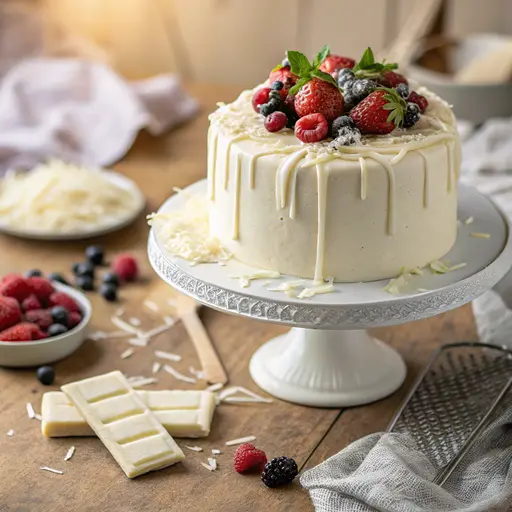Introduction
Imagine indulging in a moist, decadent cake that’s not only delicious but also suitable for those with dietary restrictions. Gluten-free white chocolate cake combines the luxurious sweetness of white chocolate with ingredients that cater to gluten-sensitive individuals. This cake isn’t just a dessert; it’s a testament to how inclusive baking can be, offering an option for everyone at the table. Whether you’re avoiding gluten for medical reasons or simply exploring new baking techniques, this cake is sure to delight your taste buds.
For those wondering about the details of gluten sensitivity, the Wikipedia article on celiac disease offers a comprehensive overview of this condition and its dietary implications.
What Does Gluten-Free Mean?
Gluten is a protein found in grains like wheat, barley, and rye. While it provides elasticity in baking, gluten can cause adverse reactions in individuals with celiac disease or gluten intolerance. Avoiding gluten requires careful selection of ingredients, ensuring that every component is free of contamination.
By embracing gluten-free diets, many people find relief from symptoms like bloating and fatigue. A deeper dive into this topic can be found on the NMRecipes blog, which explores the importance of gluten-free lifestyles in modern cooking.
Benefits of Gluten-Free Baking
- Improved Digestive Health: Gluten-free baking can help alleviate symptoms for those with gluten sensitivity.
- Inclusivity: Offering gluten-free options ensures that everyone, regardless of dietary restrictions, can enjoy your creations.
- Room for Creativity: Working without traditional flours opens doors to alternative ingredients like almond flour and coconut flour, which bring unique textures and flavors.
Transitioning to gluten-free baking doesn’t mean sacrificing flavor—it’s an opportunity to innovate and discover new culinary possibilities.
Why Choose White Chocolate for Gluten-Free Cakes?
White chocolate is an unsung hero in gluten-free baking. Its creamy, sweet flavor pairs wonderfully with gluten-free flours, balancing their sometimes nutty or earthy profiles. Additionally, white chocolate enhances the cake’s texture, keeping it moist and tender—a common challenge in gluten-free recipes.
By incorporating white chocolate, you create a dessert that feels indulgent yet accessible. The result? A cake that rivals any gluten-containing counterpart in taste and quality.
Essential Ingredients for Gluten-Free White Chocolate Cake
Crafting the perfect gluten-free white chocolate cake starts with selecting the right ingredients. Each component plays a vital role in ensuring the cake is not only delicious but also structurally sound and moist.
– Gluten-Free Flour Blends:
The foundation of any gluten-free recipe is a reliable flour blend. Combining flours like rice, almond, or tapioca ensures a balanced texture. Pre-made blends often include stabilizers, making them an excellent choice for consistency.
– High-Quality White Chocolate:
The star of the recipe is white chocolate. Choose a brand with real cocoa butter for a creamy, rich flavor. Avoid chocolates containing unnecessary fillers, as they may compromise the cake’s texture or taste.
– Binding Agents (e.g., Xanthan Gum):
Since gluten-free flours lack the elasticity gluten provides, binding agents like xanthan gum or guar gum are essential. These ingredients help maintain the cake’s structure and prevent crumbling.
– Leavening Agents:
To achieve a fluffy texture, use baking powder or baking soda. These agents ensure the cake rises properly and doesn’t turn out dense—a common pitfall in gluten-free baking.
– Sweeteners and Flavorings:
Beyond sugar, consider adding vanilla extract, almond essence, or a hint of citrus zest. These flavors complement the white chocolate, elevating the overall taste.
Step-by-Step Recipe Guide for Gluten-Free White Chocolate Cake
Creating the perfect gluten-free white chocolate cake requires precision and attention to detail. Follow this step-by-step guide to ensure your cake turns out beautifully every time.
Ingredients
For the Cake:
- 1 ¾ cups gluten-free flour blend
- 1 teaspoon xanthan gum (if not included in the flour blend)
- 1 ½ teaspoons baking powder
- ½ teaspoon baking soda
- ¼ teaspoon salt
- ½ cup unsalted butter, softened
- ¾ cup granulated sugar
- 2 large eggs
- 1 teaspoon vanilla extract
- ¾ cup whole milk (or dairy-free alternative)
- 4 ounces high-quality white chocolate, melted
For the Frosting:
- 8 ounces white chocolate, melted and cooled
- ½ cup unsalted butter, softened
- 2 cups powdered sugar
- 1 teaspoon vanilla extract
- 2–3 tablespoons milk

Preparation Steps
- Preheat and Prepare:
Preheat your oven to 350°F (175°C). Grease and line two 8-inch round cake pans with parchment paper. - Mix Dry Ingredients:
In a medium bowl, whisk together the gluten-free flour, xanthan gum, baking powder, baking soda, and salt. - Cream Butter and Sugar:
In a large bowl, use a mixer to cream the butter and sugar until light and fluffy, about 2–3 minutes. - Add Eggs and Vanilla:
Beat in the eggs one at a time, then add the vanilla extract. Mix until well combined. - Incorporate Dry Ingredients:
Gradually add the dry ingredients to the butter mixture, alternating with the milk. Begin and end with the dry mixture. - Add Melted White Chocolate:
Gently fold in the melted white chocolate until the batter is smooth.
Baking Instructions
- Divide the batter evenly between the prepared pans.
- Bake for 25–30 minutes or until a toothpick inserted into the center comes out clean.
- Let the cakes cool in the pans for 10 minutes, then transfer them to a wire rack to cool completely.
Cooling and Assembly Tips
- Once cooled, trim the cake layers for even surfaces if needed.
- Prepare the frosting by beating butter, powdered sugar, vanilla, and milk until smooth. Mix in the melted white chocolate.
- Spread frosting between the layers, then frost the top and sides of the cake.
- Decorate with white chocolate shavings or fresh berries for a stunning finish.
Enjoy your gluten-free white chocolate cake, a dessert that’s as delightful to look at as it is to taste!
Tips for Achieving the Perfect Texture and Flavor
Baking the ultimate gluten-free white chocolate cake requires more than just the right ingredients—it’s about mastering the techniques that ensure a moist, fluffy, and flavorful result. Here are some essential tips to elevate your cake.
Importance of Ingredient Temperatures
- Ensure all your ingredients are at room temperature, especially butter, eggs, and milk. This allows them to combine more smoothly, resulting in a consistent batter.
- Using melted white chocolate? Let it cool slightly before adding it to the batter to prevent it from curdling when mixed with cooler ingredients.
Mixing Techniques
- Avoid overmixing once the dry ingredients are added. Gluten-free batters are delicate, and overmixing can lead to a dense or gummy texture.
- Use the “folding” technique when incorporating melted white chocolate or delicate add-ins like nuts or zest to maintain the batter’s lightness.
Baking Time and Temperature Considerations
- Bake your cake at the specified temperature (usually 350°F/175°C) for optimal rise and texture.
- Always check for doneness using a toothpick inserted into the center. If it comes out clean or with a few moist crumbs, the cake is ready.
- Avoid opening the oven door frequently, as this can cause the cake to sink.
Avoiding Common Pitfalls
- Measure gluten-free flour correctly; scoop and level it to avoid a heavy batter.
- Don’t skip xanthan gum or similar binding agents, as they provide crucial structure in gluten-free baking.
- If the cake cracks or dries out, it may be overbaked. Adjust time slightly based on your oven’s performance.
By following these tips, your gluten-free white chocolate cake will not only taste divine but also have the perfect balance of flavor and texture to impress everyone!
Frosting and Decoration Options
When it comes to a gluten-free white chocolate cake, the frosting and decorations can elevate it from simple to spectacular. Here are some delicious and visually stunning options to make your cake a showstopper.
White Chocolate Ganache
- A velvety white chocolate ganache is a classic choice that complements the cake’s flavor perfectly.
- To make it, gently heat 8 ounces of chopped white chocolate with ½ cup of heavy cream until smooth. Allow it to cool slightly before spreading over the cake for a glossy finish.
- Drizzle extra ganache over the sides for a modern drip effect.
Cream Cheese Frosting
- For a tangy contrast to the sweetness of white chocolate, opt for cream cheese frosting.
- Beat 8 ounces of softened cream cheese, ½ cup of butter, and 2 cups of powdered sugar until fluffy. Add a splash of vanilla extract for extra flavor.
- This frosting pairs beautifully with the cake’s moist texture.
Decorative Toppings
- Berries: Fresh raspberries, strawberries, or blueberries add a pop of color and tartness.
- Nuts: Toasted almonds, pistachios, or coconut flakes provide crunch and flavor.
- Chocolate Shavings: Sprinkle white or dark chocolate curls for a touch of elegance.
Presentation Ideas
- Use a cake stand to showcase the layers and decorations.
- Add edible flowers or gold leaf for a luxurious finish.
- Arrange berries and nuts in a decorative pattern on top for a polished look.
With these frosting and decoration options, your gluten-free white chocolate cake will not only taste amazing but also look picture-perfect for any occasion.
Storage and Shelf Life
Proper storage ensures your gluten-free white chocolate cake stays fresh and delicious.
- Room Temperature: Store the cake in an airtight container at room temperature for up to 2 days if unfrosted. Frosted cakes can sit out for a day in cooler climates.
- Refrigeration: Keep the cake refrigerated in a sealed container to preserve freshness for up to 5 days. Allow it to come to room temperature before serving for the best texture.
- Freezing: Wrap individual slices or the entire cake in plastic wrap, followed by aluminum foil. Freeze for up to 3 months. Thaw overnight in the refrigerator and enjoy as fresh as day one.
Variations and Dietary Modifications
Make your cake versatile with these tweaks:
- Dairy-Free Alternatives: Use coconut milk and dairy-free white chocolate to accommodate dairy-free diets.
- Sugar Substitutes: Replace sugar with alternatives like honey, maple syrup, or a low-calorie sweetener for reduced sugar content.
- Additional Flavors: Enhance the cake with citrus zest, a pinch of cinnamon, or nutmeg for unique flavor twists. Experiment with a hint of almond or peppermint extract for festive occasions.

For more tips and creative takes, visit RecipesGeen or explore our exclusive content on NMRecipes.
Frequently Asked Questions (FAQs)
- Can I use any white chocolate for gluten-free baking?
Not all white chocolate is gluten-free. Check labels to ensure no gluten-containing additives are used. - How do I prevent my gluten-free cake from being too dense?
Use a blend of gluten-free flours and include binding agents like xanthan gum. Avoid overmixing the batter. - What’s the best way to melt white chocolate without burning it?
Melt it slowly using a double boiler or microwave in short intervals, stirring frequently to avoid overheating. - Can I make this cake vegan as well as gluten-free?
Yes! Use plant-based milk, flaxseed eggs, and dairy-free white chocolate for a vegan version.
Conclusion
Crafting a gluten-free white chocolate cake is a rewarding journey that blends creativity with inclusivity. With its rich flavor and moist texture, this cake will impress both gluten-sensitive and traditional dessert lovers alike. Try the recipe, experiment with variations, and share your feedback—your perfect slice awaits!

